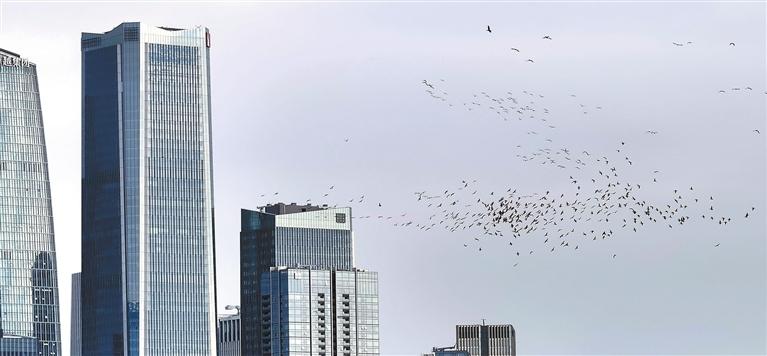
AT least 1,000 birds were killed in one day in early October, when they collided with a single Chicago building, McCormick Place Lakeside Center — the largest convention center in North America. A paradigm of architectural modernism, the Lakeside Center was built in stages from 1960 to 2017, and is a steel, concrete and glass behemoth. The building’s almost unbroken glass facade presents a problem for birds, most notably at night when the brilliantly lit interiors cause them to become confused. Although there is no group recording bird collisions in our city of Shenzhen, it can be inferred that a similar problem exists, given the large numbers of migratory birds in the Shenzhen Bay area where high-rise buildings abound. One way to prevent bird strikes is to pay more attention to the design of glass buildings in cities. Chicago set an example for this in 2009, when U.S. architect Jeanne Gang’s Aqua Tower was completed. Its wave-like facade and fritted glass were in part designed to stop birds flying into the building’s windows. Fritted glass is printed with ink and contains ultra-small particles of ground-up glass, giving it a frosted or otherwise slightly opaque appearance. This was just one aspect of Gang’s effort to “naturalize” the skyscraper — buildings that are typically composed of straight lines on account of their steel or concrete frames. As the Catalan architect Antoni Gaudí once quipped, “There are no straight lines or sharp corners in nature.” Bird-safe glass The Aqua Tower has curved balconies to soften the hard edges of what is an otherwise conventional skyscraper. The wave-like rippling effect also serves to minimize wind shear and create shade. In tandem with the fritted glass, the reflective qualities and hard edges of the glass are dampened, helping to prevent confusion, particularly at night. The tower demonstrates how architectural features usually chosen to enhance human lives can also benefit other organisms. This challenge was taken up by Buffalo-based architect Joyce Hwang in her project No Crash Zone from 2015. Hwang temporarily applied patterns to the windows of the Sullivan Center in Chicago, ostensibly to deter birds from flying into the glass, but also to add aesthetic interest to the material itself. More easily applied design solutions include bird-friendly film: A laminate of dots applied to glass to help birds see windows as objects rather than transparent, which minimizes the risk of collision. Lights out The way humans make use of artificial light, it seems, is the more intractable problem when it comes to caring for birds. In 2019, it was discovered that the annual Tribute in Light installation, held in New York City every year to mark the anniversary of the 9/11 attacks, caused migratory birds to become disorientated and exhausted. The birds are drawn to the four-mile-high beams of light, veering off their migratory routes and becoming trapped by the spectacle. In 2020, the decision was made to periodically switch off the lights and then restart them so that, even if the birds become disorientated, they can recover and continue on their way. A 2021 study carried out in Chicago demonstrated the wider application of this principle: By shutting off half the lights in larger buildings at night, bird collisions can be reduced by anything from six- to 11-fold. Nighttime illumination is bound up with the 24/7 culture of cities, yet people could choose other ways to use less artificial light. Darkness is a vital part of nature. It is the means by which animals, and plants, rest and take cover. For migratory birds, darkness is a safe place; it also allows them to perceive the world as they need to, with the light of the Moon and stars (and their sensitivity to the Earth’s magnetic field) guiding their long journeys.(SD-Agencies) | 
